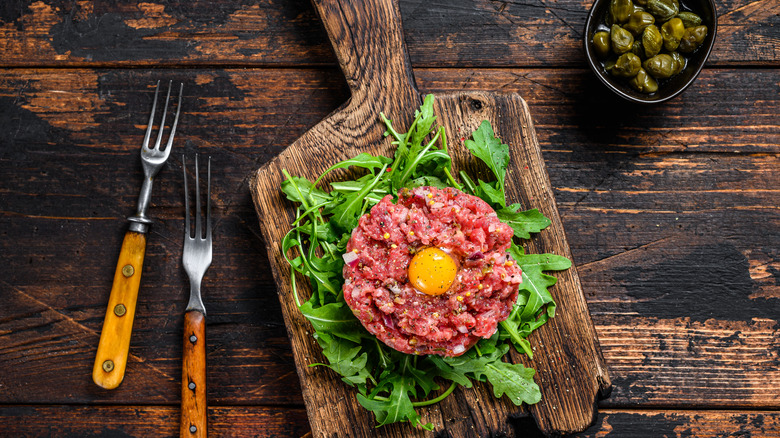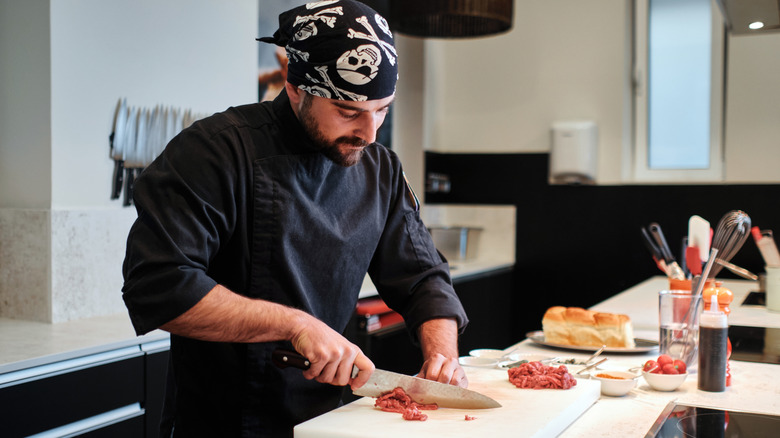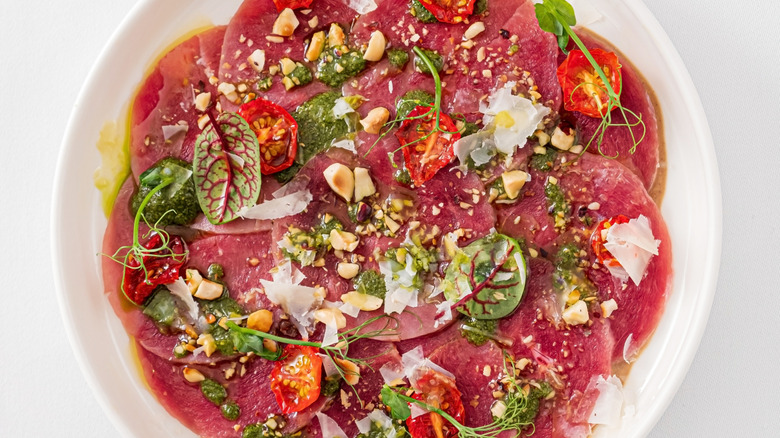Why You Shouldn't Even Bother Making Steak Tartare At Home
We get it — the allure of steak tartare in all of its luxurious glory is one of those dishes that makes you feel like you're fine dining at a French bistro. There are so many questions about this fancy dish, like where did it get its name from, who thought to eat beef raw, and why does it cost so much in the first place. Perhaps that last one, the ticket price, has motivated you to try your hand making it at home. But, you might want to take a second and reconsider that idea because attempting this dish at home may cause you more harm than you bargained for.
While it may look simple enough to just grab minced raw beef and season it with spices and herbs before adding a raw egg yolk on top, the reality is that it requires a level of precision and safety that's difficult to replicate outside of a professional kitchen. Because the meat is never cooked, any mistake in handling or sourcing the beef can lead to serious health risks, which is why so many chefs advise leaving this dish to the experts.
Professional kitchens have strict food safety protocols that most home cooks simply don't follow on a day-to-day basis. Everything from the source of the beef to the equipment used for preparation must be carefully controlled. If any step goes wrong, you're putting yourself at risk, and when it comes to raw meat, that's a gamble not worth taking.
Why steak tartare is a professional-only dish
What makes steak tartare so risky to prepare at home is the fact that absolutely nothing is cooked, which means there's no kill step for bacteria. Colleen Garcia, director of curriculum and content development at the Auguste Escoffier School of Culinary Arts, told The Takeout that steak tartare is one of the 16 dishes you should leave to professional chefs because the dish requires a "surgical approach to food safety and equipment cleanliness."
She notes that professional chefs go to great lengths to reduce risk. "Professional chefs carefully source the beef for steak tartare from the most reputable sources, and then chefs will sanitize and sometimes freeze their knives and cutting boards before beginning preparation. Precision cuts are essential for quality, and under no circumstances should things like ground or pre-diced meats be used, since there is a much higher risk of bacterial contamination," Garcia says. "Since nothing in the dish is cooked, preventing cross-contamination is paramount and should best be left to the professionals."
For the average home cook, achieving that level of cleanliness and control is extremely difficult. Many kitchens don't have the same sanitation practices or access to high-quality, freshly cut beef that professional chefs do. Even if you think you're being careful, there's a significant risk of cross-contamination when handling raw meat and eggs.
Safer alternatives to beef tartare
If you're intrigued by the flavors of steak tartare but nervous about the safety risks (as you should be), there are other dishes that can satisfy the craving without the same level of danger. Seared beef dishes, like carpaccio-style seared steaks sliced thin, can give you a similar texture and flavor profile with a much lower risk. Cooking the meat, even briefly, can kill harmful bacteria while still leaving the interior tender and flavorful.
You can also look to dishes that mimic the seasoning and presentation of steak tartare without using raw beef. Chopped, cooked steak tossed with capers, herbs, mustard, and other tartare-style flavors can hit many of the same notes without requiring the precision and sanitation needed for raw preparation.
Though you could be tempted to recreate restaurant favorites at home, steak tartare is a no-go. Without professional-grade food safety measures, it's a dish best left for dining out.


